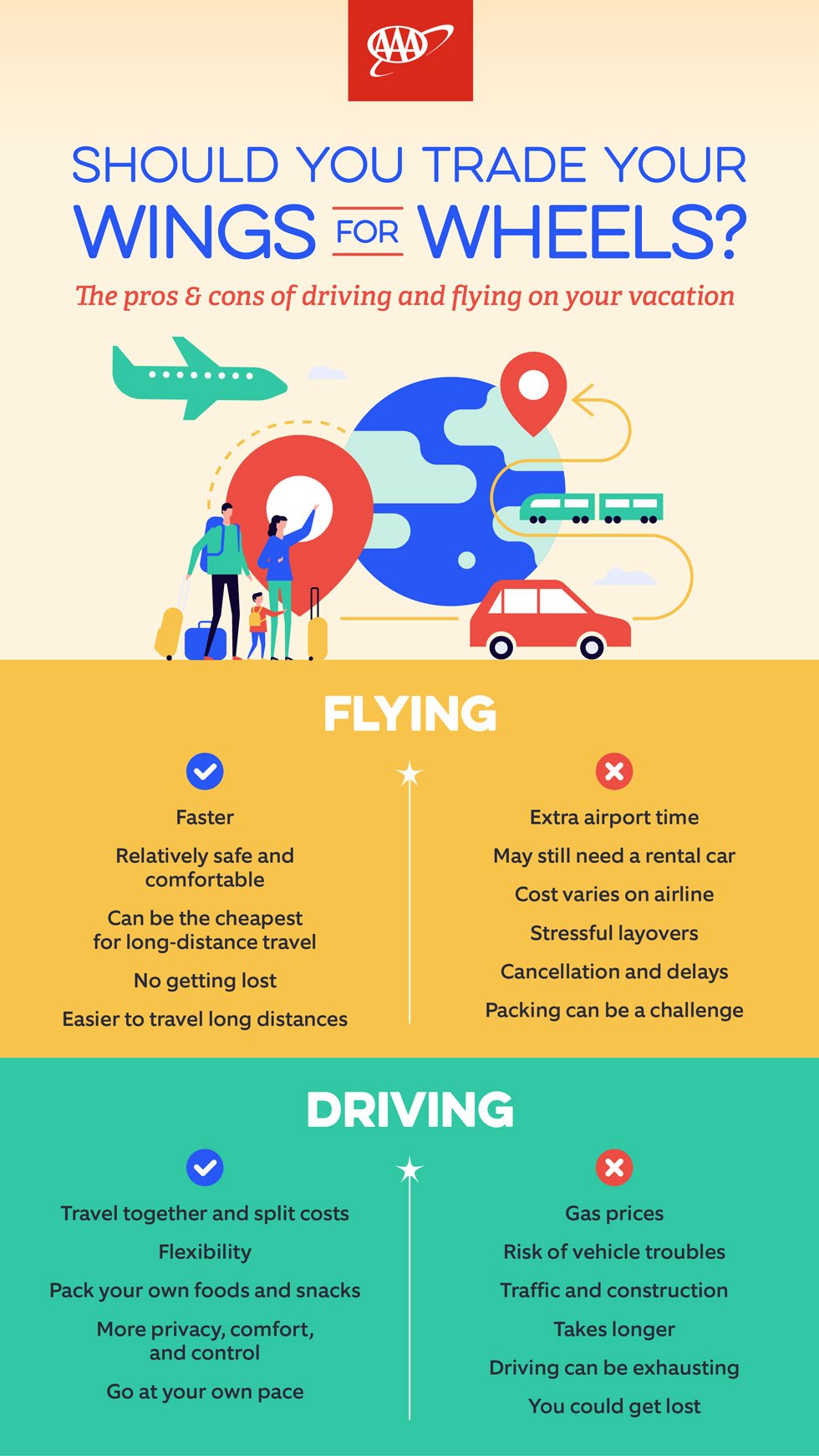
If you’re planning a vacation this year, one of your first decisions may be whether to fly or drive. Both have their advantages and disadvantages, with differences in cost, convenience, and overall enjoyment. Ultimately, the best choice comes down to your budget, destination, schedule, and personal preferences.

The cost of flying for your vacation
In 2024, the average cost for a round-trip domestic flight was approximately $378, according to the US Department of Transportation’s Bureau of Transportation Statistics. The Bureau also reports that, in the third quarter of 2024, the average airfare for domestic flights departing from the 10 busiest airports in the US was as follows:
| City and airport | Cost of airfare |
| Los Angeles (LAX) | $385.79 |
| Chicago-O’Hare (ORD) | $344.51 |
| Denver (DEN) | $337.33 |
| Atlanta (ATL) | $396.12 |
| Newark (EWR) | $402.85 |
| Boston (BOS) | $331.19 |
| Seattle (SEA) | $378.35 |
| Dallas (DFW) | $392.31 |
| Orlando (MCO) | $269.61 |
| San Francisco (SFO) | $424.68 |
Several factors influence the cost of your flight, including the departure and arrival airports, time of year, day of week, time of day, the airline, type of flight, and more.
For example, flights tend to be more expensive during the summer, on weekends, and for nonstop routes. Additionally, many airlines charge extra fees, such as for checked bags (an average of $35 to $40 per bag) and for selecting a seat in advance ($10 to $100 or more depending on the airline, the seat, and the route).
The good news is that there are plenty of ways to save on airfare, including the following:
- Book your flight at the right time.
- Fly out of an alternative airport.
- Set price alerts, and monitor flight price changes.
- Be flexible with your departure and/or arrival dates and times.
- Choose flights with layovers instead of nonstop options.
- Using credit card points or miles to purchase your flight.

The cost of driving for your vacation
The cost of a road trip also varies based on factors such as your starting location, destination, gas prices, and vehicle type (including your car’s fuel economy). A general rule of thumb is to budget around $150 per person per day. Depending on how far you’re traveling, your budget also should account for:
- vehicle maintenance and potential repairs;
- overnight accommodations;
- meals and snacks; and
- tickets or other expenses for attractions or other stops along the way.
Gas is often one of the biggest factors in the fly vs drive equation. Today’s national average for a gallon of gas is hovering around $3, with prices ranging by region. Since gas prices can fluctuate often and sometimes dramatically, estimate around $3.50 per gallon when budgeting.
If your vehicle gets an average of 25 miles to the gallon and has a 13-gallon tank, you can estimate your fuel costs for different distances as follows:
- 250 miles – approximately $35
- 500 miles – approximately $70
- 750 miles – approximately $105
- 1,000 miles – approximately $140
Remember to double the cost if you’re driving roundtrip.
Hotel and overnight accommodation costs vary widely depending on the location, hotel class, and time of year. On average, a hotel stay costs between $170 to $180 per night, though prices can be significantly higher in major cities. In 2024, over 20 percent of hotels in the top 25 US markets charged more than $200 per night.
To keep road trip costs down, try the following tips:
- Set a budget, and stick to it.
- Opt for budget-friendly accommodations, such as motels or vacation rentals.
- Pack your own drinks and snacks.
- Book attraction tickets in advance to take advantage of discounts.
- Redeem credit card rewards or use fuel rewards programs for gas savings.

Pros and cons
Along with cost, consider what’s most important to you when it comes to your vacation, such as flexibility in your itinerary, travel time, and control.
Pros of flying
- Getting to your destination faster
- Enjoying relatively safe and comfortable travel
- Cost-effective option for long-distance travel
- No planning, stopping, or getting lost
- Easier to travel long distances
Cons of flying
- Security lines, layovers, and potential delays, plus spending more time in the airport before your flight
- Potential additional transportation costs (e.g., renting a car or relying on public transit)
- Pricey airfare, depending on the route, season, and airline
- Stress, especially if you have layovers
- Strict schedules, leaving little room for spontaneity
- Flight delays or cancellations
- Challenges of packing light
Pros of driving
- Friends and family traveling in one vehicle can split the costs.
- Flexibility and freedom with your itinerary – stop or take a detour whenever you want.
- Take as much luggage as you like, and it’s easier to pack.
- Pack your own foods and snacks, saving you money.
- Offers more privacy and comfort.
- Allows for more control over your vacation budget.
Cons of driving
- High – and somewhat unpredictable – gas prices.
- Taking the risk of vehicle troubles, which could impact your plans and budget.
- Potential stress of traffic, construction, detours, etc.
- Takes more time, especially for longer trips.
- Getting tired and having less energy for your actual vacation.
- Getting lost or dealing with unreliable GPS directions.

You decide: Fly or drive?
For a shorter trip, driving is usually the more cost-effective option, while for longer cross-country journeys, flying is often the cheaper and more convenient choice.
Ultimately, the decision between flying or driving for your vacation comes down to your personal preferences. Flying may be more expensive and sometimes stressful, but it will get you to your destination faster and with less effort—unless you experience flight delays and cancellations. Driving, on the other hand, is typically more budget-friendly and allows for greater flexibility in terms of pace, stops, and spontaneous detours. For long-distance destinations, though, driving will take more travel time and planning.
Ultimately, the decision often comes down to which mode of travel best suits your trip and your travel style.

